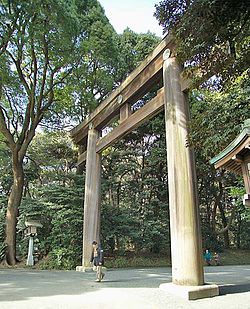Japan is a country with a rich cultural heritage and strong traditions and beliefs. One of Japan’s ancient religions is Shinto and like with most religious beliefs, it is in a sense a way of life. Built on many virtues, harmony with nature is one of the religion’s main values. It also places great emphasis on Kami or divine spirits. Kami can be anything from human beings to elements of nature and the Meiji Jingu Shrine is made in honour of Emperor Meiji and Empress Shoken who was his wife.
 Emperor Meiji is widely known as Meiji the Great; his rule over Japan began during a time of turmoil but according to many he was instrumental in the country becoming a world power by the end of his reign. It was Emperor Meiji who changed the capital’s name to Tokyo, and worked towards bringing great prestige to the city. Though Empress Shoken was his wife, she bore no children and the Emperor had fifteen children from his five concubines; unfortunately most did not live to reach adulthood.
Emperor Meiji is widely known as Meiji the Great; his rule over Japan began during a time of turmoil but according to many he was instrumental in the country becoming a world power by the end of his reign. It was Emperor Meiji who changed the capital’s name to Tokyo, and worked towards bringing great prestige to the city. Though Empress Shoken was his wife, she bore no children and the Emperor had fifteen children from his five concubines; unfortunately most did not live to reach adulthood. The Meiji Jingu Shrine is an Imperial Shrine and was built in a garden that the Emperor and his wife were known to frequent. The area surrounding the temple is a forest for which more than 100,000 saplings were donated from all corners of Japan as well as overseas. The original building was demolished during World War II, though subsequently restoration work began and the new shrine was completed by 1958.
The Meiji Jingu Shrine is an Imperial Shrine and was built in a garden that the Emperor and his wife were known to frequent. The area surrounding the temple is a forest for which more than 100,000 saplings were donated from all corners of Japan as well as overseas. The original building was demolished during World War II, though subsequently restoration work began and the new shrine was completed by 1958.The current shrine can be primarily divided into two sections, the Naien and the Gaien. The Naien is the inner area and includes the treasure museum which has a splendid display of articles used both by the Emperor and the Empress. The Gaien is the outer area and has 80 paintings that bring to life the events that occurred in the lives of Emperor Meiji and Empress Shoken.
Those visiting the city and looking for a luxury hotel Tokyo can stay at The Peninsula Tokyo. Offering luxurious accommodation options, this hotel Tokyo makes an ideal base from which to experience the sights and sounds of this cosmopolitan city.
Related posts
HOT TOPICS
Archives
Categories
- Activities (824)
- Adventures (102)
- Dining (41)
- Events & Festivals (44)
- Kids Pools (6)
- Playgrounds (2)
- Restaurants (9)
- Theme Parks (30)
- Destinations (2,072)
- Family Travel Tips (729)



